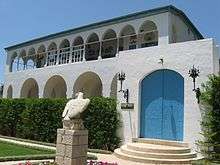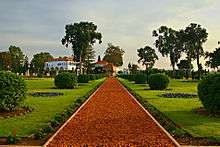Mansion of Bahjí



The Mansion of Bahjí (Arabic: delight) is a summer house in Acre, Israel where Bahá'u'lláh, the founder of the Bahá'í Faith, died in 1892. His shrine is located next to this house. The whole area was called Al-Bahjá (Place of Delight).
The area was originally a garden planted by Sulayman Pasha, who was the ruler of Acre, for his daughter Fatimih, and he named it Bahji.[1] Later the area was further beautified by `Abdu'llah Pasha, and in 1831 when Ibrahim Pasha besieged Acre he used the property as his headquarters.[1] The property was well known for its beautiful gardens and pond fed by an aqueduct. The property then fell into the possession of a Christian family, the Jamals.[1]
In 1870 `Udi Khammar, a wealthy merchant from Acre who also originally owned the House of `Abbúd, bought some of the land from the Jamals close to the mansion of `Abdu'llah Pasha and built the Mansion of Bahji, over an earlier and smaller building, which Abdu'llah Pasha had had built for his mother.[2][1][3] `Udi Khammar had built the house for his family, and when he died was buried in a tomb in the south-east corner of the wall directly around the building.[1][4] In 1879 an epidemic caused the inhabitants to flee and the building became vacant.
`Abdu'l-Bahá first rented, and then purchased, the mansion for Bahá'u'lláh and the Bahá'í holy family to live in, and Bahá'u'lláh moved from Mazra'ih to Bahji and resided in the building until his death.[1][4] In 1890 the Cambridge orientalist Edward Granville Browne met Bahá'u'lláh in this house; after this meeting he wrote his famous pen-portrait of Bahá'u'lláh.[3]
When Bahá'u'lláh died in 1892 he was interred in one of the surrounding buildings, and that building became the shrine of Bahá'u'lláh.[3] After his death in 1898, Bahá'u'lláh's son Díyá'u'lláh was initially buried next to his father. However, having been declared a Covenant-breaker, Díyá'u'lláh's remains were disinterred in a "process" of "purification" through "cleansing" the "inner sanctuary" of the "most hallowed shrine," the "Qiblih" of the "Bahá'í World." [5] The site has since been beautified with paradise gardens, which are termed Haram-i-Aqdas (the Most Holy Precincts or Sanctuary) and are intersected by a circular path which serves to circumambulate the shrine of Bahá'u'lláh.[3] The Mansion, shrine, and surrounding gardens are among the most sacred spots on earth for Bahá'ís and are Bahá'í pilgrimage sites.[1][3]
See also
Notes
- 1 2 3 4 5 6 7 Balyuzi 2000, p. 362
- ↑ David Ruhe, "Door of Hope", page 106
- 1 2 3 4 5 Smith 2000, pp. 87–89
- 1 2 Taherzadeh 1987, p. 103
- ↑ Marks, Geoffry W., ed. (1996). Messages from the Universal House of Justice 1963-86: The Third Epoch of the Formative Age. Baha'i Publishing Trust. p. 66. ISBN 978-0877432395.
References
- Balyuzi, H.M. (2000). Bahá'u'lláh, King of Glory. Oxford, UK: George Ronald. ISBN 0-85398-328-3.
- Smith, Peter (2000). "Bahjí". A concise encyclopedia of the Bahá'í Faith. Oxford: Oneworld Publications. ISBN 1-85168-184-1.
- Marks, Geoffry W., ed. (1996). Messages from the Universal House of Justice 1963-86: The Third Epoch of the Formative Age. Baha'i Publishing Trust. ISBN 978-0877432395.
- Taherzadeh, A. (1987). The Revelation of Bahá'u'lláh, Volume 4: Mazra'ih & Bahji 1877-92. Oxford, UK: George Ronald. ISBN 0-85398-270-8.
External links
| Wikimedia Commons has media related to Bahjí. |
- Bahá'í Pilgrimage - Mansion of Bahjí
- "The Bahá'í Gardens - Official Website". Bahá’í World Centre. 2009-03-20.
Coordinates: 32°56′36″N 35°05′32″E / 32.94333°N 35.09222°E